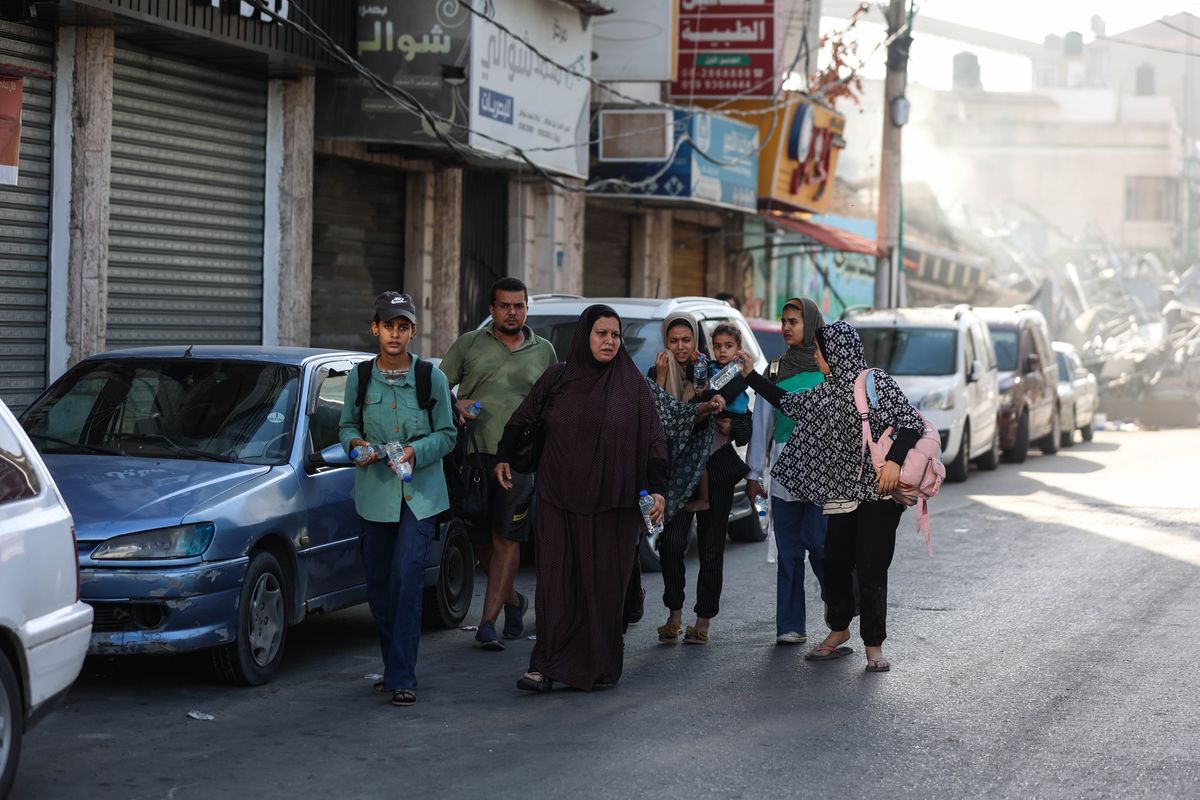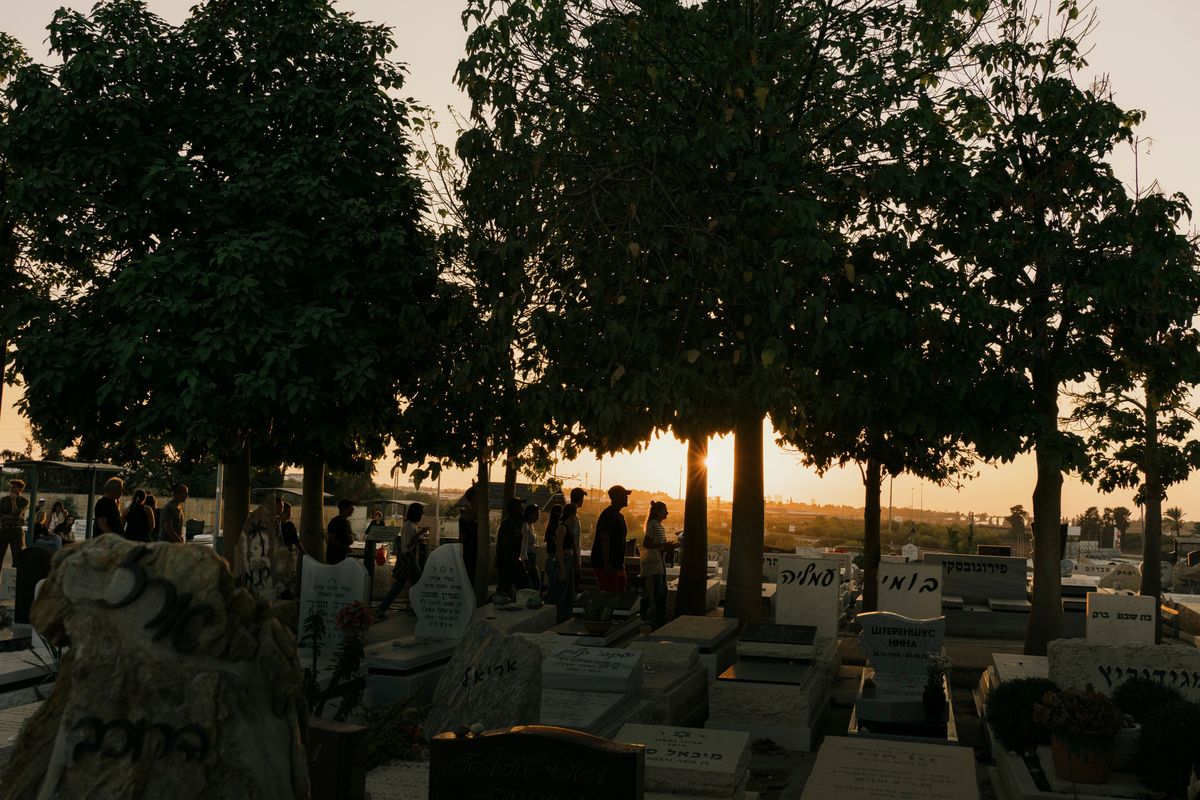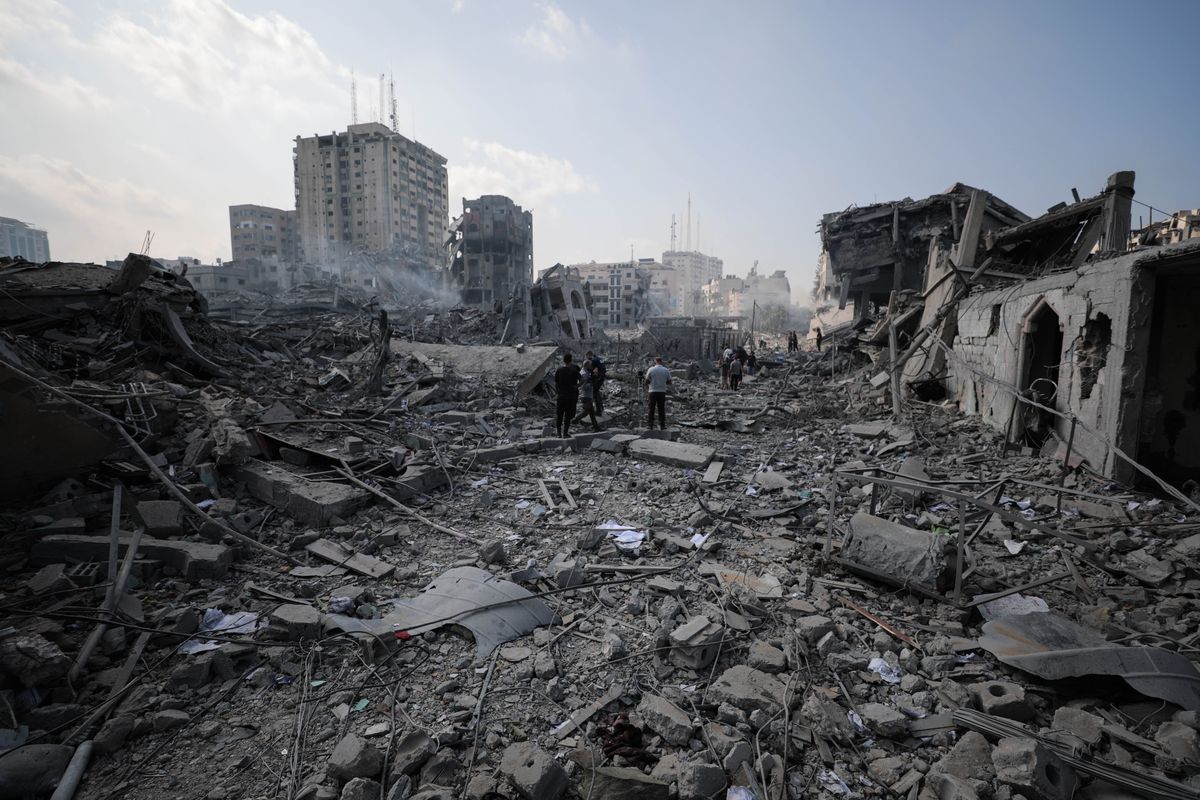Have war crimes been committed in Israel and Gaza?
Mourners leave the funeral of Kim Demati, 22, in Gadara, Israel, on Thursday. She was killed at the site of a music festival near the border fence with Gaza during an attack by Hamas militants. (Lorenzo Tugnoli/For the Washington Post)
As the war between Israel and Hamas escalates in Gaza, both sides have said they are adhering to international law.
Senior Hamas leader Moussa Abu Marzouk told the Economist this week that his group, which led the attacks that killed more than 1,300 people in Israel, “obeys all international and moral laws.” He said the operation targeted only “military posts,” despite clear evidence that hundreds of civilians were among those killed by Palestinian militants.
Israeli officials have also said that their punishing strikes against Hamas in Gaza – where entire neighborhoods have been turned to rubble – were in compliance with international humanitarian law.
“We are working, operating militarily in terms according to rules of international law, period. Unequivocally,” Israeli President Isaac Herzog said at a media briefing Friday.
Herzog added that Gazans “could have risen up” against Hamas. “We are at war. We are defending our homes. We are protecting our homes,” he said. “That’s the truth. And when a nation protects its home, it fights. And we will fight until we break their backbone.”
The United Nations and other rights groups have criticized Israel’s military campaign as indiscriminate, saying it violates international humanitarian law by putting civilians at risk. The Israeli military’s alleged use of white phosphorus, an incendiary weapon prohibited under international law, and its warning Friday to Gaza residents to evacuate the northern part of the enclave, have raised fears of a humanitarian catastrophe.
In theory, the International Criminal Court at The Hague could bring charges if it suspects war crimes are being committed by either party. Israel is not a party to the Rome Statute that founded the court. The Palestinian territories joined the ICC in 2015, giving the court jurisdiction over crimes committed there – including in Gaza – or by Palestinian nationals in other territories.
In practice, however, international calls for justice are rarely without controversy – especially within the context of the Israeli-Palestinian conflict, which has roots dating to the late 19th century.
Can civilians be targeted under international humanitarian law?
The deliberate targeting of civilians is forbidden by the central tenets of international humanitarian law, as laid out in the Geneva Conventions of 1949 and later, in more detail, in the 1977 Additional Protocols.
Article 3 of the Third Geneva Convention prohibits “violence to life and person, in particular murder of all kinds, mutilation, cruel treatment, and torture” against people who are “taking no active part in the hostilities.” Article 51 of the Additional Protocols says that civilians “shall not be the object of attack” and that “acts or threats of violence the primary purpose of which is to spread terror among the civilian population are prohibited.”
There is also something called the “principle of distinction” from the Additional Protocols. This means that parties to a conflict have to distinguish between combatants and noncombatants, i.e. civilians, so the latter are not harmed.
In its surprise assault on Oct. 7, Hamas militants infiltrated and attacked Israeli military bases, killing some soldiers and taking others hostage. But its fighters also fanned out into local farming communities and to an outdoor music festival, where they terrorized and gunned down hundreds of civilians, including children.
Some Hamas officials have said that they do not consider Israelis living in settlements in the West Bank or in towns near Gaza as civilians.
Israel, which was established in 1948, captured the West Bank and Gaza during the Six Day War in 1967 and continues to occupy the West Bank. Israel unilaterally withdrew from Gaza in 2005 but has maintained an air, land and sea blockade of the territory. Egypt also sealed its border with Gaza after Hamas seized control from the Palestinian Authority in 2007.
Can civilian areas be targeted if military groups are present?
Israel has said that its airstrikes are aimed at Hamas military infrastructure and weapons depots in Gaza. It has also indicated that it will soon launch a ground invasion with the goal of removing Hamas from power.
Officials have accused Hamas and other militant groups of hiding and operating among civilians in Gaza, where roughly 2 million live in an area about twice the size of Washington, D.C.
International humanitarian law attempts to limit the scope and intensity of military actions in civilian areas, which would include much of Gaza. Article 51 of the Additional Protocols also prohibits “indiscriminate” attacks on an area that contains both military and civilians, given the risk that the attack could harm the latter.
It says one definition for this would be any attack that would be “expected to cause incidental loss of civilian life, injury to civilians, damage to civilian objects, or a combination thereof, which would be excessive in relation to the concrete and direct military advantage anticipated.” This has been called the “principle of proportionality.”
There is some nuance, however. The same article in the Additional Protocols also states that the presence of civilians alone cannot be used to “shield military objectives from attacks or to shield, favour or impede military operations.”
What if a party to the conflict warns civilians ahead of an attack?
In the past, Israel has issued messages designed as warnings before striking a site in Gaza where there could be large numbers of civilians. In some cases, these were direct phone calls to residents.
In others, they were less subtle. Israel in previous conflicts has relied on what is known as “roof knocking,” a practice that includes striking the roof of a home or building with a low-yield explosive to warn residents of a bigger, impending strike.
On Friday, Israel issued a blanket warning to more than 1 million Gaza residents to evacuate the northern part of the territory. Israel first alerted the United Nations to the plan, then issued public statements and dropped fliers over parts of Gaza, which is hemmed in by a joint Israeli-Egyptian blockade.
U.N. officials said that the order could prove “calamitous” for civilians, while rights groups charged that it did not comply with humanitarian law. Gaza’s border crossings to Israel and Egypt are both closed.
“Ordering a million people in Gaza to evacuate, when there’s no safe place to go, is not an effective warning,” Clive Baldwin, senior legal adviser for Human Rights Watch, said in a statement. “The roads are rubble, fuel is scarce, and the main hospital is in the evacuation zone. This order does not alter Israel’s obligations in military operations to never target civilians and take all the measures it can to minimize harm to them.”
Also Friday, the spokesman for Hamas’s military wing, the Izzedine al-Qassam Brigades, urged Gaza residents to “stand firm” after the evacuation order. He issued the statement as an audio message that was broadcast on Al Jazeera.
What is ‘collective’ punishment?
Collective punishment is prohibited in Article 33 of the Fourth Geneva Convention: “No protected person may be punished for an offence he or she has not personally committed. Collective penalties and likewise all measures of intimidation or of terrorism are prohibited.”
Article 51 of the Additional Protocols also states that “attacks against the civilian population or civilians by way of reprisals are prohibited.”
Even before the recent fighting, U.N. human rights experts condemned Israel’s treatment of the Palestinians, particularly in Gaza, where they said Israeli actions amounted to a form of collective punishment.
On Tuesday, a U.N.-linked Commission of Inquiry said that it was “gravely concerned with Israel’s latest attack on Gaza and Israel’s announcement of a complete siege on Gaza involving the withholding of water, food, electricity and fuel which will undoubtfully cost civilian lives and constitutes collective punishment.”
The U.N. Human Rights Council mandated the commission in 2021 to investigate alleged violations of international humanitarian law in Israel and the Palestinian territories.
Soon after the attacks in Israel, Defense Minister Yoav Gallant announced a “full siege” of the Gaza Strip, saying that “no electricity, no food, no fuel” would be allowed in. A separate U.N. expert panel said Thursday the siege has put Gaza’s population at “inescapable risk of starvation.”
The Rome Statute, which founded the ICC, specifically prohibits “intentionally using starvation of civilians as a method of warfare by depriving them of objects indispensable to their survival.”
Is using white phosphorous a war crime?
Video filmed on Wednesday appears to show Israel’s military using white phosphorus in Gaza, according to an analysis by Human Rights Watch. The Israel Defense Forces denied using white phosphorus, calling the allegations “unequivocally false.”
Israeli forces have used white phosphorus in previous operations in Gaza. In 2009, several white-phosphorus shells fired by the Israeli military hit a U.N.-run school in the city of Beit Lahiya, killing at least two.
White phosphorus is an industrial chemical with incendiary properties. Once a munition explodes, the chemical inside creates thick white smoke. White phosphorus can burn human flesh to the bone and can even reignite when bandages are removed because it reacts to oxygen.
The U.N. Convention on Certain Conventional Weapons bans the use of incendiary weapons in civilian areas.
Though there are some tactical military uses of white phosphorus that are considered acceptable, its potential for indiscriminate harm in populated areas could make it a war crime under other international humanitarian law.
Israel said in 2013 that it would stop using the munitions.
“White phosphorus should never be used in civilian areas, and Gaza is one of the most densely populated areas in the world,” Brian Castner, a weapons investigator with Amnesty International, said in an email to the Washington Post after reviewing the footage.
What does international humanitarian law say about taking hostages and the use of ‘human shields’?
Hamas is believed to have taken at least 64 people hostage from Israel, according to a review of visual evidence from the Post. Israeli officials have accused the group of using the hostages as “human shields.”
The capture of these hostages and their potential use in conflict zones to avoid military operations are prohibited under international law.
“Taking hostages in the context of hostilities constitutes a war crime,” the United Nations said in a statement Thursday. “The civilians taken by Hamas must be immediately released, pending which their fate and whereabouts must be disclosed.”
Article 34 of the Fourth Geneva Convention says specifically that the “taking of hostages is prohibited,” while Article 147 describes it as a “grave breach” of the convention. The Rome Statute additionally says that “utilizing the presence of a civilian or other protected person to render certain points, areas or military forces immune from military operations” is a war crime.
Is the targeting of hospitals, schools or religious buildings allowed during war?
The Geneva Conventions include numerous provisions that prohibit attacks on hospitals, schools or religious buildings such as mosques or synagogues.
“Civilian hospitals organized to give care to the wounded and sick, the infirm and maternity cases, may in no circumstances be the object of attack,” Article 18 of the Fourth Geneva Convention states, while Article 53 of the Additional Protocols says that it is prohibited “to commit any acts of hostility directed against the historic monuments, works of art or places of worship which constitute the cultural or spiritual heritage of peoples.”
The conventions also prohibit the use of these buildings for military purposes, however, and carve out some exceptions if the building is being used for “harmful acts.” However, they say the presumption is against that unless there is direct proof.
“In case of doubt whether an object which is normally dedicated to civilian purposes, such as a place of worship, a house or other dwelling or a school, is being used to make an effective contribution to military action, it shall be presumed not to be so used,” Article 52 of the Additional Protocols states.
Article 19 of the Fourth Geneva Convention says: “The fact that sick or wounded members of the armed forces are nursed in these hospitals, or the presence of small arms and ammunition taken from such combatants and not yet been handed to the proper service, shall not be considered to be acts harmful to the enemy.”
In Israel, Post reporters who toured communities targeted by Hamas reported evidence of violence in a kindergarten.
Health workers in Gaza also said Friday that Israeli strikes had damaged at least 10 medical facilities since the military campaign began on Oct. 7.



